09/14/2018
Read Time: Minutes
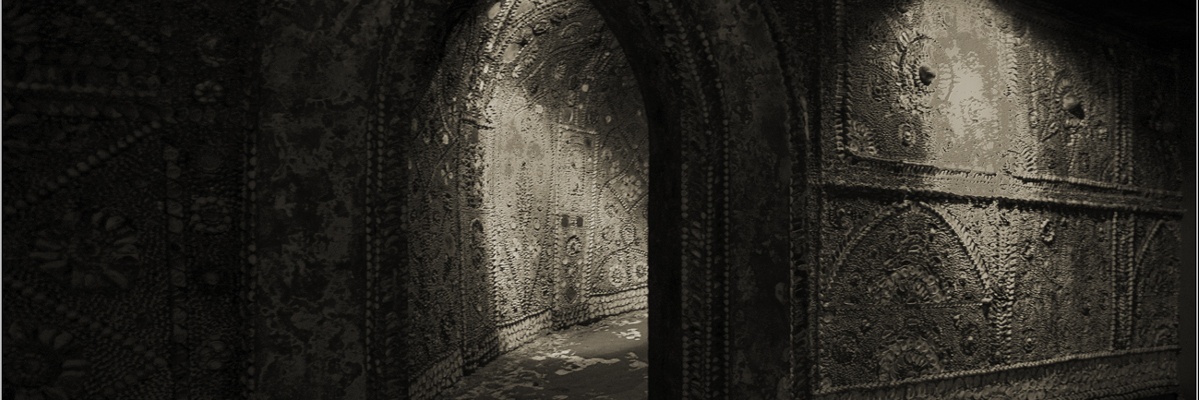
Shell Grotto is one of the few places on Earth where it is not known who built it – or when.
Discovered in 1835, the grotto’s purpose also remains largely a mystery. In this article, we will take a closer look at who might have built it and for what purpose.
From the 16th century onwards, grottoes were built, especially in Italy and France. Decorated by fountains, waterfalls, precious stones and shells, they were used as baths, chapels or theaters. In England, a total of only 20 to 30 grottoes are known, 2 of which are in Margate alone. In addition to the Shell Grotto, the Margate Cave can be found there, but it has been closed since 2004 because of safety and health risks.
Margate is a small coastal town of about 57,000 people in the county of Kent in southeast England. It has a proud maritime history and has been a popular vacation destination for Londoners since the mid-18th century because of its sandy beaches.
Although the town tries to maintain some semblance of an attractive resort, nowadays Margate – like so many other English seaside towns – is but a shadow of its bygone glory days. The Shell Grotto is probably one of the few attractions that draws tourists to the sleepy seaside town these days.
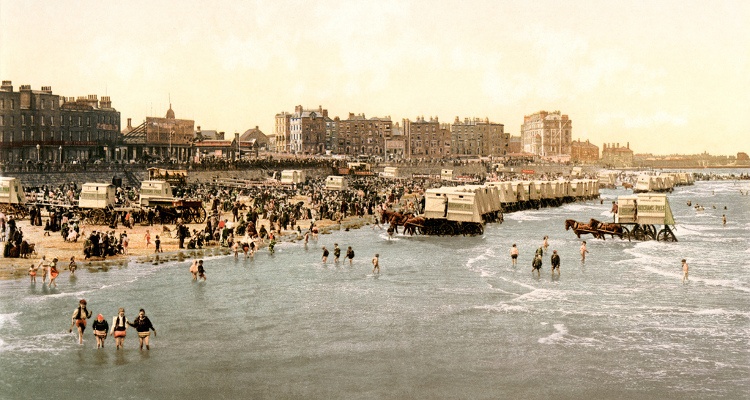
Margate in 1895 | © trialsanderrors / CC BY 2.0 / flickr.com
In 1835, James Newlove was actually only trying to dig a duck pond when he penetrated an underground opening with his shovel through the ground. He then sent his son into the newly discovered cave with the help of a rope. The latter quickly discovered that the cavity could not be of natural origin.
Three years later, the public was also able to see for themselves. The Shell Grotto quickly became a local tourist attraction.
From the outside, the Shell Grotto looks quite unimpressive – especially in an area that has seen better days.
When you enter the small entrance building, you’re met with a gift store, a café, and a museum that tells the story of the grotto.
A staircase leads to a narrow passage called the North Passage. At the end of the North Passage, one enters the so-called Rotunda, a circular passage that in turn leads to a room flooded with daylight and with a dome open to the sky.
From there, the so-called serpentine passage leads to a rectangular room known as the altar room. The vaulted ceiling and parts of the wall of the chancel were destroyed during the 2nd World War and subsequently restored without the shell ornaments.
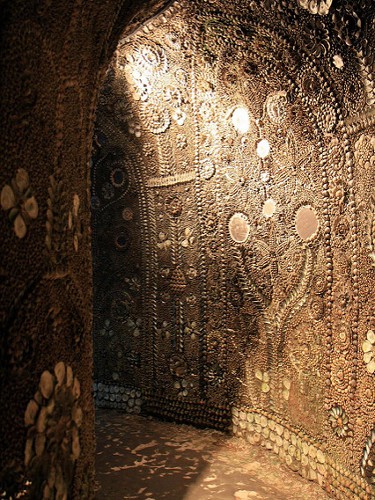
Passage in the Shell Grotto | © Barney Moss / CC BY 2.0 / flickr.com
The walls and ceilings of the entire Shell Grotto are covered with millions of shells that form the most diverse motifs. These motifs can be divided into different areas. Each area has a specific theme, a story that is told. At the same time, many representations can be interpreted in different ways.
For example, depending on the interpretation, the representations can be seen as typical Indian or Egyptian motifs. With a little imagination, a turtle, a crocodile, trees, flowers, gods, a sun, a moon, stars and trumpets and the tree of life can be recognized. All of these symbols have no explicit reference to Christianity, which is surprising since England has been Christian for over a thousand years.
99% of the shells in the Shell Grotto are from shellfish found on the English coast; including mussels, oysters, clams, whelks, razor clams, and limpets. Only in the sanctuary are exotic shells or carapaces of mollusks from the Caribbean, such as the carapace of a Great Fencer Snail.
In the past, the interior of the grotto must have been a colorful place. Today, the shells have lost their magnificent appearance because they are covered by a layer of soot, which comes from the gas lamps used in the Victorian era. It is not possible to clean them with water, as it could severely damage the shells.
That’s why they focus on the best possible conservation of the current state. With more than 4.6 million shells and carapaces of various molluscs used, spread over more than 600m² of wall and ceiling space, this is a workload that should not be underestimated.
The construction of the Margate Grotto must also have taken a considerable amount of time. Researchers, however, completely disagree on when the builders lived – or who they were in the first place. Some even date the shell grotto back to prehistoric times, while others think it likely that it was built at the time of the Romans or Phoenicians. Others place the beginnings of the Shell Grotto in modern times, more precisely in the 18th century – not long before the rediscovery.
The reason for the estimates being so far apart, is the lack of dated materials, leaving room for a variety of speculations. Radiocarbon dating is possible, but costly, as multiple samples would have to be taken to distinguish “repair shells” from original shells. Those responsible for the shell grotto want to concentrate first on the urgently needed conservation work.
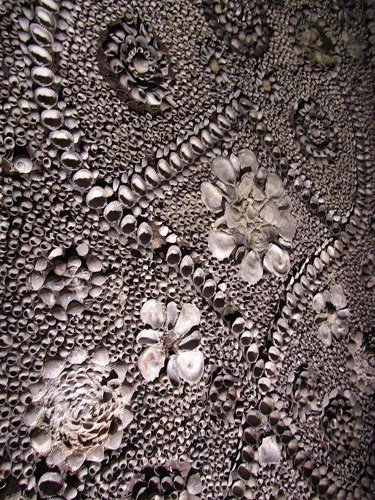
Shell ornaments on the wall of the shell grotto of Margate | © DenesFeri / CC BY-SA 2.5 / Wikimedia Commons / image cropped
Traces of tools that could allow a conclusion about the builders are not present. The mortar holding the shells to the walls and ceilings was analyzed. The samples showed that several compounds were used – mostly based on a “fish-like” material also known as Roman cement. This probably tempts some researchers to date the creation of the shell grotto back to Roman times.
According to some locals, it was built during the time of Queen Victoria. At that time, mussel fishing increased to such an extent that enough mussel shells remained as a by-product, which could have been used to decorate the grotto.
This is contradicted by the fact that at that time nobody in Margate had heard of the construction of such a grotto. In such a small place rather improbable. Until the opening in 1837 nobody knew anything about the Shell Grotto.
Others suggest that the arch construction of the grotto ceiling indicates that it was built in the 14th century. At that time, this architectural design was extremely popular. Again, the argument against this is that this construction may have been chosen not because of its architectural design, but simply because it poses the least risk of collapse – compared to a flat roof, for example.
The builders have not yet been identified. What about the purpose of the Shell Grotto?
Since the Shell Grotto at Margate cannot be placed in any time period and, accordingly, any culture, it is difficult to come up with an approach to purpose.
However, some assumptions that have been made about the period can be refuted.
The grotto was not a dungeon – it is too beautifully decorated for that. Nor was it a quarry. There are other more obvious places in the area for that. Besides, quarries are not excavated in the form of arch constructions.
The possibility that the cave was used as a smuggler’s den in the past can also be ruled out. The smugglers would have built at least one escape tunnel for this purpose – and if they smuggled their goods by ship, at least one tunnel to the coast as well. The wall decorations also speak against this assumption.
Short English language video about Shell Grotto
Others suspected that the grotto was a so-called folly (literally “folly”). Folly is an English term in garden art and architecture for a decorative structure distinguished by its underlying eccentric idea and a particularly extravagant execution. Wealthy people built them to show off their wealth – from 1700 onwards, they also increasingly built arbors and grottoes decorated with shells. Margate’s shell grotto was built on farmland. It is not known that anyone wealthy lived there long ago. Moreover, the Shell Grotto is underground, which would also contradict the purpose of a follie to impress other people with its wealth. Accordingly, this theory does not seem to be confirmed either.
The assumption that the shell grotto of Margate was a place of worship is probably closer to the truth. The altar room has a niche, which could have been used as an altar – by this assumption the room logically got its name.
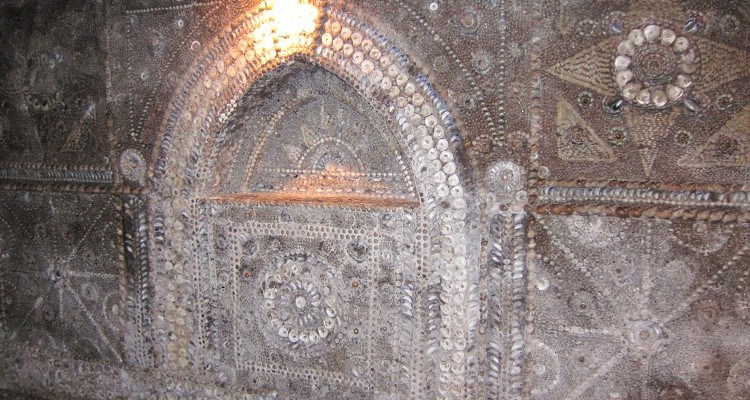
Altar in the Shell Grotto | © Oast House Archive / CC BY-SA 2.0 / geograph.org.uk / image cropped
The rotunda also makes sense in this context. In some religions, concentric walking is a common method of contacting the gods.
Mick Twyman, researcher from the Margate Historical Society , has theorized after extensive research of his own that Freemasons used this place to perform their rituals. In addition to the possible altar, which was also used in known Masonic rituals, shell depictions inside the Shell Grotto showing some Masonic symbols such as a compass, square, Star of David, pentagram, tetrahedron and tablets with symbols of ancient gods support this theory.
Twyman not only investigated the possible purpose of the grotto, but also wondered about the date of its creation.
In his opinion, the upward-opening dome at the end of the rotunda could have functioned as a sundial between March and October. Sunlight projected through the opening onto the dome took the shape of an egg at 12:00 a.m. on June 21, 2006, and was reflected on the belly of a mosaic serpent, which in turn reflected the sun’s rays onto the altar in the sanctuary. Twyman made complex calculations, taking into account the angle of the equinox, which changes every 72 years, and concluded that the year of origin must be 1141 AD.
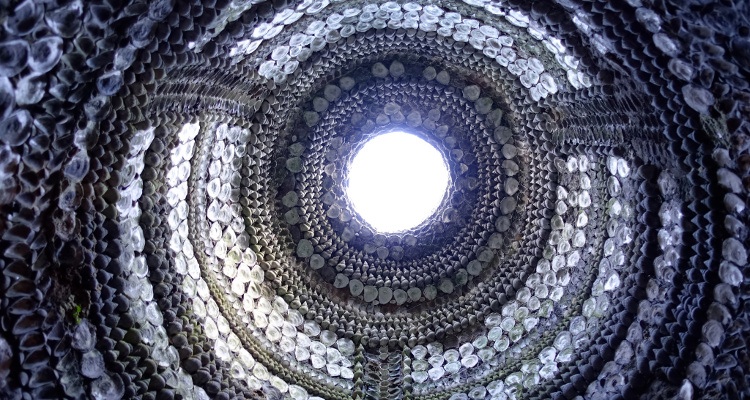
Opening in the dome of the Shell Grotto | © Martin Hearn / CC BY 2.0 / flickr.com
As builders he suspects not the Freemasons, who in 1141 AD according to official historiography did not even exist, but the Knights Templar. The researcher concluded this after looking at the size and construction of the grotto itself – especially the angles.
So, in summary, Twyman says that the Knights Templar built the Shell Grotto in 1141 A.D. for unknown reasons, and then at a later time the Freemasons used the site to perform their rituals. According to Twyman’s theory, it was consequently the Masons who added all or at least some of the shell ornamentation, as many contain Masonic symbolism.
In contrast, an employee of the Kent Archaeological Society came to a very different conclusion. He published his findings shortly after Mick Twyman in a 14-page document in which he ultimately concluded that the Shell Grotto was a medieval chalk mine.
He continues, “The skill required to cut the passages to fit a relatively complex, predetermined plan suggests that the grotto may have been reworked in the 17th century, but more likely in the 18th century. It is likely that the shell decoration was done at the same time or very shortly thereafter.”
As to the intended use, however, the author of this document has no valid theory.
Whether either theory will be proven or disproven in the near future will have to be determined by further investigation, ideally radiocarbon dating. With the current state of investigations, there is too much room for too many theories.